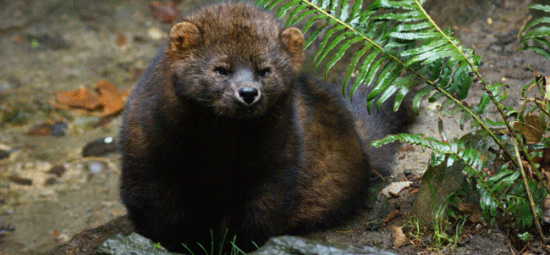Photo: U.S. Fish and Wildlife Service.
PREVIOUSLY
###
The U.S. Fish and Wildlife Service abruptly withdrew its nomination of the Pacific fisher for protection under the federal Endangered Species Act, saying that voluntary agreements between regulators and large timberholders will be enough to restore habitat for the West Coast population of the species and halt its decline.
At the same time, the Weyerhaeuser Company announced that it would voluntarily adopt measures to manage some three million acres of its Oregon and Washington timberlands in a way that would lessen the impact of timber harvesting on fisher habitat, and would also fund efforts to reintroduce the animal to parts of its historic range.
Once common throughout North American forests, the fisher, a large member of the weasel family, has seen its range dramatically reduced in the western United States, due to impacts from timber harvesting, trapping and — most recently — the use of rodenticides, often in association with large-scale marijuana farming.
Efforts to get the Pacific population of fishers listed as threatened or endangered date back to at least 2000, and the U.S. Fish and Wildlife Service has often championed them. Back in September 2014, it made an official recommendation, based, it said, on the “best available scientific and commercial information,” to list the local population of the fisher under the act. The service still maintains a page trumpeting this action on the “Saving Wildlife” section of its website.
In the intervening months, though, the service’s view of the situation changed.
“There has been a substantial increase in support and interest by federal, state, tribal, and private stakeholders in implementing voluntary and proactive fisher conservation measures,” said Robyn Thorson, the USFW Service’s Pacific Region director, in a press release yesterday. “It is clearly resulting in a much improved long term conservation outlook for fisher.”
Meanwhile, the Center for Biological Diversity, a litigious environmental organization, called the decision “a case of politics trumping science,” and said that it was considering a challenge to the decision in court.
“The politically driven reversal of proposed protection for the fisher is the latest example of the Fish and Wildlife Service kowtowing to the wishes of industry,” said attorney Tanya Sanerib in the center’s own press release. “Fishers may be tough enough to prey on porcupines, but they need Endangered Species Act protection to survive.”
Northern California fishers have been much in the local conversation in recent years, thanks to the work of Dr. Mourad Gabriel, whose research has shown that anticoagulant rodenticides commonly used in marijuana farming have killed many of the now-rare mammals. In 2013, Sheriff Mike Downey was famously photographed with a dead fisher found at a 8,000+ acre plant trespass grow.
A 349-page “species report” prepared by the U.S. Fish and Wildlife Service last month contains a long, updated discussion of the effects of anticoagulants on fisher populations. According to the latest available research, it says, as many as 84 percent of fisher corpses found in California test positive for some level of exposure to such poisons.
###
ELSEWHERE
- West Coast Population of Fisher Will not be Listed Under Endangered Species Act (US Fish and Wildlife Service.)
- Weyerhaeuser commits three million acres in Washington and Oregon to support the reintroduction of the North American Fisher (Weyerhauser press release)
- West Coast Fisher Denied Endangered Species Act Protection in Bow to Timber Industry (Center for Biologican Diversity press release)
- In about-face, feds deny endangered species protections for Pacific fisher (Oregonian)
- Pacific fisher denied protection under the Endangered Species Act (Los Angeles Times)
DOCUMENT
- Final Species Report — Fisher, West Coast Population (US Fish and Wildlife Service, March 2016).

CLICK TO MANAGE